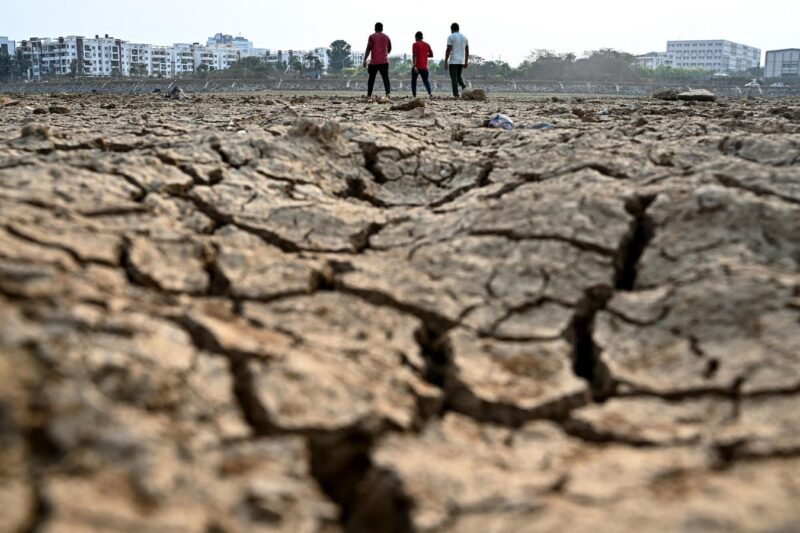TOPSHOT – Men walk across the arid Nallurahalli lake at Whitefield in Bengaluru on March 10, 2024. (Photo by Idrees MOHAMMED / AFP) (Photo by IDREES MOHAMMED/AFP via Getty Images)
AFP via Getty Images
While India is one of the world’s fastest-growing economies and a top-three producer of solar energy, the country remains extremely vulnerable to the impacts of climate change. And its children are the most vulnerable. A recent study revealed that children living in the most climate-vulnerable districts in India are at a greater risk of not only being underweight but also suffering from stunted development, along with greater difficulties in accessing health care.
“Our findings reveal that climate change has a significant and distinct association with poor health outcomes even after accounting for other well-established determinants for good health such as mothers’ education, birth orders of children, and access to health care facilities, in alignment with findings from major assessments,” the researchers wrote in their study that was published in the journal PLoS One on November 26, 2025. “Districts that are highly vulnerable to climate change tend to underperform on health metrics, including stunting, wasting, being underweight, non-institutional deliveries, and difficulties accessing healthcare. Similar adverse findings for maternal and child health and nutrition attributable to climate change have been observed elsewhere.”
“Increasingly, climate change has become a major force disrupting health care delivery, undermining the social determinants of good health and reducing the capacity to provide health care, including universal health coverage, with the potential of significantly increasing health costs in LMICs,” the researchers further explained in the study. “Harsh geographic conditions, long distances to health centres, limited transportation, lack of services, absence of adequate and trained health care professionals, and financial barriers have often been noted as impacting access to equitable and quality health care.”
Their findings revealed that the North Western desert state, Rajasthan, has the highest number of districts which are either “very highly or highly vulnerable to climate change.” The second most climate vulnerable state is Jharkhand (located in East India), followed by Chhattisgarh in Central India and the Himalayan state of Uttarakhand in North India.
“In absolute terms, the area, climatic conditions, geographic features and number of districts vary widely across states. It is revealing that the extent of vulnerability to climate change is not clustered uniquely by geographical location. Within a state, the vulnerability to climate change can vary substantially across constituent districts,” the researchers highlighted. “For instance, among the larger states, districts in Gujarat, West Bengal, Uttar Pradesh and Uttarakhand have high within-state variability in the distribution of districts by levels of climatic vulnerability. Several districts in the North Eastern region of the country have high levels of climatic vulnerability, with all districts in Arunachal Pradesh being highly vulnerable.”
“Tracking climate disaster impacts and integrating these with health outcomes will lead to better health system preparedness, including surveillance, flood and heat resilient health infrastructure, stocking up on medicines and essential supplies according to vulnerability profiles, and training of personnel to respond in a sustained manner, including paramedics and community health workers,” they added. “Cost-effective investment decisions need to consider the differentials in climate vulnerability across sub-national regions in health sector decision-making for effective implementation. Tackling climatic vulnerability is essential for progressing on the SDG targets, and ignoring these can lead to delays and setbacks, most of which are avoidable. Effective climate resilient practices include communities in implementation and planning, empower local governance and strengthen self-help groups to enhance adaptive capacity.”
The good news is that in the last decade, India has seen improvements in its maternal and child healthcare services, thanks to the intiatives and efforts undertaken by the government’s National Health Mission that helped in reducing the financial burdens that women face while attempting to access health and child care. Especially because some state-level government schemes have incentivized women to give birth in hospitals, as opposed to home deliveries.
The other good news is that over the last few years, these schemes have yielded results as India’s child mortality rates have reduced significantly, although as of today, health disparities still persist in underdeveloped regions and particularly among historically oppressed caste communities.
Other than that, gender disparities persist in India, just like in other parts of the world. Female children under the age of 5 years are far more vulnerable to malnutrition than male children in the same age group, as some households tend to prioritize the needs of male children over girls.









